#source: david firth
Explore tagged Tumblr posts
Photo
Me on the way to the kitchen for some midnight roasted onions

#david firth#dog of man#indie animation#disturbing source material#Cartoon blood and gore#cartoon gore
36 notes
·
View notes
Text
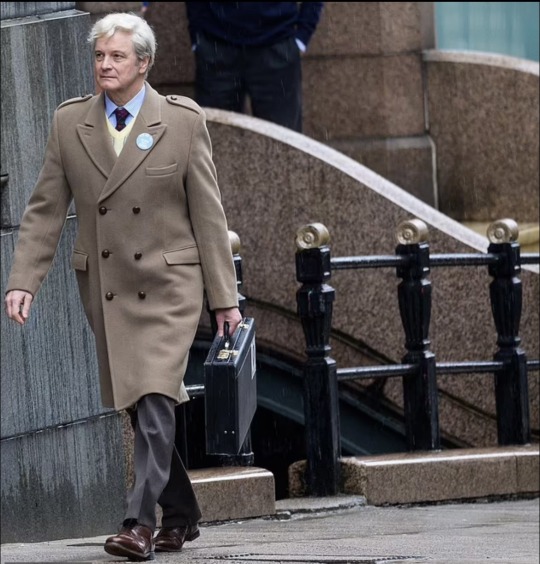
Colin Firth, filming Lockerbie and embodying Dr Jim Swire, 88, in Glasgow as he sported Jim's famous 'Lockerbie: The Truth Must Be Known' badge. 📸 © Wattie Cheung
Sky drama and Peacock “Lockerbie”.

It's not the one original series "Lockerbie," about the 1988 flight disaster. Sky and Peacock began filming in Scotland in February and BBC, Netflix and MGM started programming in March.
The cast members in Lockerbie Colin Firth (The King’s Speech, A Single Man, The Staircase) join Catherine McCormack (Slow Horses, Temple, Lucan) to play Jane Swire opposite Firth’s Dr Jim Swire.
Known as the Lockerbie bombing and the Lockerbie air disaster in the UK, it was described by Scotland's Lord Advocate as the UK's largest criminal inquiry led by the smallest police force in Britain, Dumfries and Galloway Constabulary.
The five-part series, featuring Oscar-winning actor Colin Firth, is based on the tragic Lockerbie terror attack on 21st December 1988 when Pan Am flight 103 from London to New York exploded over the Dumfries and Galloway town, killing all 259 on board and 11 residents.
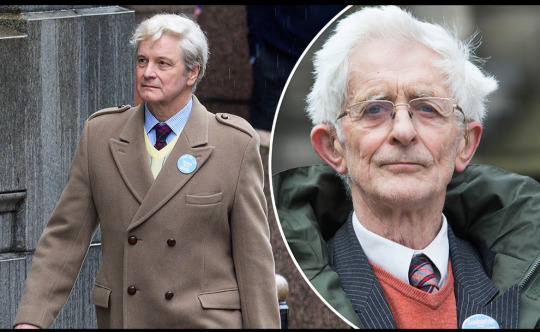
Colin Firth, will play Dr Jim Swire, a doctor who lost his daughter, Flora, in the 1988 tragedy. Writers also took inspiration from Jim's book, The Lockerbie Bombing: A Father's Search for Justice.
In the wake of the disaster, Dr Jim Swire (Firth), is nominated spokesperson for the UK victims’ families, who have united to demand truth and justice. Travelling across continents and political divides, Jim embarks on a relentless journey that not only jeopardises his stability, family and life, but completely overturns his trust in the justice system. As the truth shifts under Jim’s feet, his view of the world is left forever sullied.
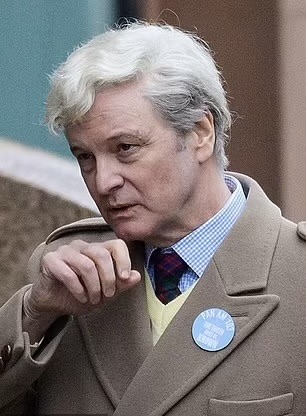
Colin dyed his hair a whitish shade of grey to match Jim's and wore a tartan tie. 📸 © Wattie Cheung
Firth was seen on the set of the new drama in Linlithgow, which will close several roads in the east end and city centre during the filming. Colin was spotted in character and has taken on the role of Jim, 88, the father of one of the 270 victims of the 21st December 1988 Lockerbie bombing.
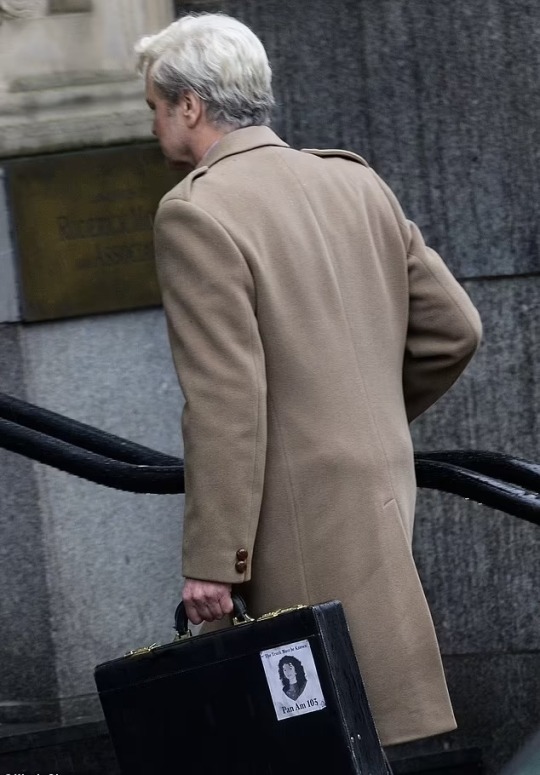
At the back of Colin's briefcase was a drawing of Jim's daughter, Flora Swire, who was on her way to the US to spend Christmas with her boyfriend when Libyan terrorists blew up the plane.
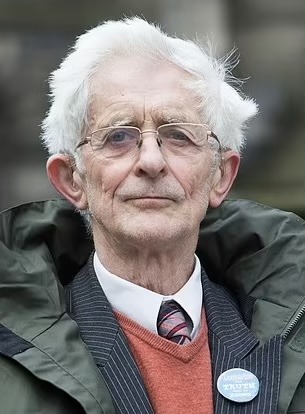
The real Jim (pictured in 2015) became famous after the bombing for his relentless lobbying towards a solution for the difficulties in bringing suspects in the original bombing to trial 📸 © PA
The series is based on the book The Lockerbie Bombing: A Father’s Search for Justice by Jim Swire and Peter Biddulph – as well as other sources.
Lockerbie bombing, The new drama, Flight 103: Film crew in Linlithgow to work on, have been spotted in Glasgow as filming begins in the city. Road closures are in place as filming kick starts.

A film crew is currently filming in Linlithgow working on a new TV series based on the Lockerbie disaster.
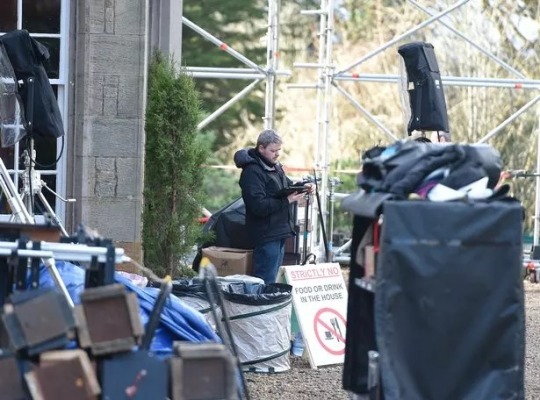
Linlithgow is situated between Edinburgh and Glasgow, to the south of the Firth of Forth and on the edge of Linlithgow Loch. Linlithgow Palace, Stewart residence, birthplace of Mary Queen of Scots, and rest stop between Edinburgh Castle and Stirling Castle.
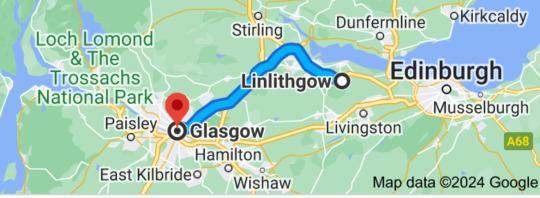
It had been noticed for its similarity to the original Pan Am Flight 103 which exploded over the town of Dumfries and Galloway, 40 minutes into its flight from London to New York.

@getty Images
Scottish playwright David Harrower (Blackbird, Knives in Hens) is the lead writer. Maryam Hamidi (Vigil) is guest writer on an episode. Additional writing comes from Jim, Kirsten and Naomi Sheridan.
BAFTA Award-winning Otto Bathurst (Peaky Blinders, The Winter King) is lead director. Jim Loach (Save Me) will also direct an episode. Gareth Neame and Nigel Marchant are Executive Producers for Carnival Films. Sam Hoyle is Executive Producer for Sky Studios. Additional Executive Producers include David Harrower, Otto Bathurst, Liz Trubridge, Jim Sheridan, Kirsten Sheridan and Oskar Slingerland.
youtube
A true story with an Academy Award®-winning actor Colin Firth not to be missed 📍
#Lockerbie #ColinFirth #DrJimSwire #book #TheLockerbieBombing: AFather'sSearchfor Justice #SKY #Peacok #truestory #bombing #CatherineMcCormack #Linlithgow #Scotland #PanAmflight103 #DumfriesandGalloway #disaster #filming #newdrama #FloraSwire #JaneSwire #series #Libyanterrorists #plane #LockerbieairdisasterintheUK #policeforce
A release date for the series hasn't yet been set.
Posted 6th March 2024
14 notes
·
View notes
Text

David Firth Photo-Graphics
Winter Dunes
Artpropelled.tumblr.com
Source: Flickr
4 notes
·
View notes
Text




Studying Linguistics
Here's what I learned today:
🌿 Languages are made up of signs. Signs are the combination of letters and sounds that we give meaning to.
🌿 Modern Linguistics began in the 19th century
🌿 European colonialist linguistics used a classification and comparison method to understand language better, by compiling various word lists and grammars from other languages to break down their similarities and differences. William Jones is credited as the founder of comparative linguistics.
🌿 Despite being credited with this discovery, William Jones was in fact not the first to discover that the ancient Indian language of Sanskrit was related to European languages. That credit goes to Panini, who was a famous grammarian and way ahead of his time, surpassing European linguistic achievements.
🌿 Ferdinand de Saussure is said to be the "father of linguistics" with his groundbreaking contributions. His influence would not only influence linguistics as a whole, but anthropology and semiotics as well. After his death, a book was published titled "Course in General Linguistics" in 1916.
🌿 Early modern linguistics focused heavily on phonetics and phonology.
🌿 In 1886, the International Phonetic Association (IPA) was established by Europeans in Paris, and is still around to this day.
Important schools/branches of modern linguistics:
🇨🇿 The Prague School: focused on phonological theory and is remembered for their contributions to syntax.
🇬🇧 British Structuralism: J.R. Firth's theory of meaning, emphasizing context and is summarised as "meaning is use in context".
My sources 🩷💖🩷💖:
How Language Works by David Crystal
An Outline of the History of Linguistics, California State University (pdf)
#history of linguistics#studyblr#linguistics#david crystal#penguin books#new journey#sources linked#intro to linguistics
1 note
·
View note
Text
[Transcript: a video depicting catified designs of Kayla, Tayrun, Benny, Alexis, Sterling, Heath, Astra, Dr. Champagne, Mara, Vasilia, Jake, Ana, Kate and Archie from Multiverse Tales.
For each section of the video, the design is on the left side of the screen, while on the right is a bordered list featuring (from top to bottom) the character’s name, the voice claim, and the source of the sample lines used. The lists are as follows:
Bio-Mech Kayla
Voice Claim | Lila (Elsie Lovelock in general tbh)
Audio Source | various Spooky Month episodes
-
Tayrun Janavaar
Voice Claim | Ramsay Cole
Audio Source | Jurassic World Dominion
-
Benny Sharp
Voice Claim | Scout
Audio Source | Meet the Scout
-
Alexis Jones
Voice Claim | Erica Luttrel
Audio Source | Steven Universe
-
Sterling Engeal
Voice Claim | TheOdd1sOut
Audio Source | TheOdd1sOut out of context compilation
-
Heath Hurricane
Voice Claim | Chase Beck
Audio Source | Chase Beck 2022 animation reel
-
Astra
Voice Claim | Marceline
Audio Source | Adventure Time - Best of Marceline
-
Dr. Champagne
Voice Claim | Bandit Heeler
Audio Source | Bandit Heeler in pain compilation
-
Coşmara Noroi
Voice Claim | Jaiden Animations
Audio Source | Jaiden Animations out of context compilation
-
Vasilia Kuznet
Voice Claim | Emma Breezy
Audio Source | Emma Breezy 2019 demo reel; ENA - Temptation Stairway
-
Jake Taygen
Voice Claim | Finn the Human
Audio Source | Adventure Time pilot
-
Ana Fenze
Voice Claim | Sadie Miller
Audio Source | Steven Universe Sadie compilation
-
Unkillable Kate
Voice Claim | Lord Dominator
Audio Source | Lord Dominator being an aro lesbian
-
Gooby/Archie
Voice Claim | David Firth
Audio Source | David Firth’s Health Reminder Ep 3
0 notes
Text

23 notes
·
View notes
Photo



Hornblower S1 + Patreon credits from David Firth’s “Cream”
14 notes
·
View notes
Photo
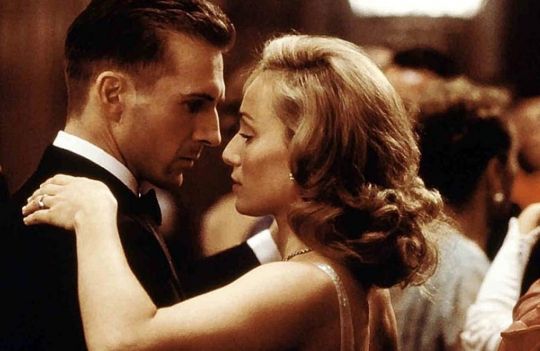
Ralph Fiennes and Kristin Scott Thomas in The English Patient (Anthony Minghella, 1996)
Cast: Ralph Fiennes, Juliette Binoche, Willem Dafoe, Kristin Scott Thomas, Naveen Andrews, Colin Firth, Julian Wadham, Jürgen Prochnow, Kevin Whately, Clive Merrison, NIno Castelnuovo. Screenplay: Anthony Minghella, based on a novel by Michael Ondaatje. Cinematography: John Seale. Production design: Stuart Craig. Film editing: Walter Murch. Music: Gabriel Yared.
The "prestige motion picture" is a familiar genre: It's typically a movie derived from a distinguished literary source or a biopic about a distinguished historic figure, with a cast full of major actors, but designed not so much to advance the art of film as to attract critical raves and awards -- particularly Oscars. There are plenty of examples among the best-picture Oscar winners: A Man for All Seasons (Fred Zinnemann, 1966), Chariots of Fire (Hugh Hudson, 1981), Gandhi (Richard Attenborough, 1982), Amadeus (Milos Forman, 1984), Out of Africa (Sydney Pollack, 1985), and The Last Emperor (Bernardo Bertolucci, 1987). (The 1980s seemed to be particularly dominated by prestige-seekers.) The trouble is that once the initial attraction of these films has faded, few people seem to remember them fondly or want to watch them again. I'd rather watch The Battle of Algiers (Gillo Pontecorvo, 1966) today than sit through A Man for All Seasons, and I would say the same for Atlantic City (Louis Malle, 1981), Blade Runner (Ridley Scott, 1982), Starman (John Carpenter, 1984), Prizzi's Honor (John Huston, 1985), and Moonstruck (Norman Jewison, 1987) when put in competition with the prestige best-picture winners of their respective years. So I watched The English Patient last night to test my theory that prestige movies don't hold up over time. It fits the category precisely: It's based on a Booker Prize-winning novel by Michael Ondaatje; it has a distinguished cast, three of whom were nominated for acting Oscars, including Juliette Binoche, who won; it earned raves from The New Yorker, the New York Times, and Roger Ebert; it raked in 12 Oscar nominations and won nine of them -- picture, supporting actress, director Anthony Minghella, cinematographer John Seale, art direction, costumes, sound, film editor Walter Murch (who also shared in the Oscar for sound), and composer Gabriel Yared. And sure enough, there are films from 1996 that I'd rather watch again than The English Patient, including Fargo (Joel Coen and Ethan Coen), Lone Star (John Sayles), and Trainspotting (Danny Boyle). But I also have to say that of all the "prestige" best picture winners, The English Patient makes the best case for the genre. It's a good movie, with a mostly well-crafted screenplay by Minghella from a book many thought unfilmable, though it still tries to carry over too much from the novel, such as the character of David Caravaggio (Willem Dafoe), whose function in the film, to provoke Almásy (Ralph Fiennes) into uncovering his story, could have been served equally well by Hana (Binoche). But the performances still seem fresh and committed. Binoche, though designated a supporting actress, carries the film by turning Hana into a kind of central consciousness. I was surprised at how much heat is generated by Fiennes and Kristin Scott Thomas as Katharine, considering that they are both usually rather icy performers. There are some beautifully staged scenes, like the one in which Kip (Naveen Andrews) "flies" Hana so she can view the frescoes high in a church. And Murch's sound editing gives the film a marvelous sonic texture, starting with the mysterious clinking sounds at the film's beginning, which are then revealed to be the bottles carried by an Arab vendor of potions. Murch's ear and Seale's eye make the film an enduring audiovisual treat.
5 notes
·
View notes
Text
19th March 1286: “A Strong Wind Will Be Heard in Scotland”
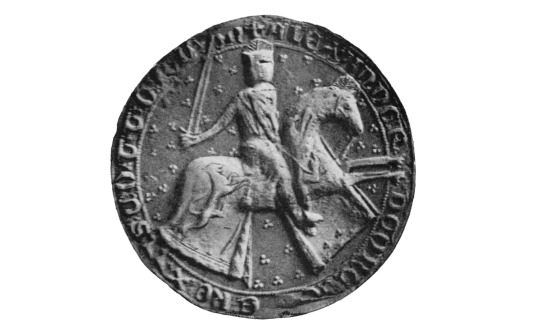
(Image source: Wikimedia Commons)
On 19th March 1286, a body was discovered on a Fife beach, not far from the royal burgh of Kinghorn. The corpse was that of a 44-year-old man, and the cause of death was later diversely reported as either a broken neck or some other severe injury consistent with a fall from a horse at some point during the previous night. It is not known exactly when this body was found, nor do we know who discovered it. But we do know that the dead man was soon identified, with much dismay, as the King of Scots himself, Alexander III.
The late king had no surviving children, only a young widow who was not yet known to be pregnant, and an infant granddaughter in the kingdom of Norway. Despite this, Alexander III’s untimely death did not cause any immediate civil strife, although it did set in motion a chain of events which eventually led to the Scottish Wars of Independence. This conflict would forever alter the relationship between the kingdoms of Scotland and England, as well as the wider course of European history.
Although Alexander III was a moderately successful monarch, he had been unfortunate over the last ten years. His first wife, Margaret of England, had died in 1275 and Alexander initially showed no immediate interest in remarriage. At first the succession seemed secure: Margaret had left behind two sons and a daughter. However the death of the couple’s younger son David c.1281, may have prompted the king’s decision to arrange the marriages of his two surviving children over the next few years. In the summer of 1281, the twenty-year-old Princess Margaret set sail for Bergen, where she was to marry King Eirik II of Norway. Her brother Alexander, the eighteen-year-old heir to the throne, married the Count of Flanders’ daughter in November 1282. Neither marriage lasted long. The queen of Norway died in spring 1283, possibly during childbirth, while her younger brother succumbed to illness in January 1284. Within a few years, a series of unforeseen tragedies had destroyed Alexander III’s family and hopes, and the outlook for the kingdom seemed equally bleak...
All was not lost however. The king was in good health and believed he could count on the support of the realm’s leading men. Steps were swiftly taken to ensure their compliance with his plans for the succession. On 5th February 1284, a few weeks after Prince Alexander’s death, an impressive number of Scottish nobles* set their seals to an agreement at Scone. In the event of the king of Scotland’s death without any surviving legitimate children, they obliged themselves and their heirs to accept as monarch the heir at law. This was currently a baby named Margaret, the only surviving child of Alexander III’s daughter the queen of Norway.
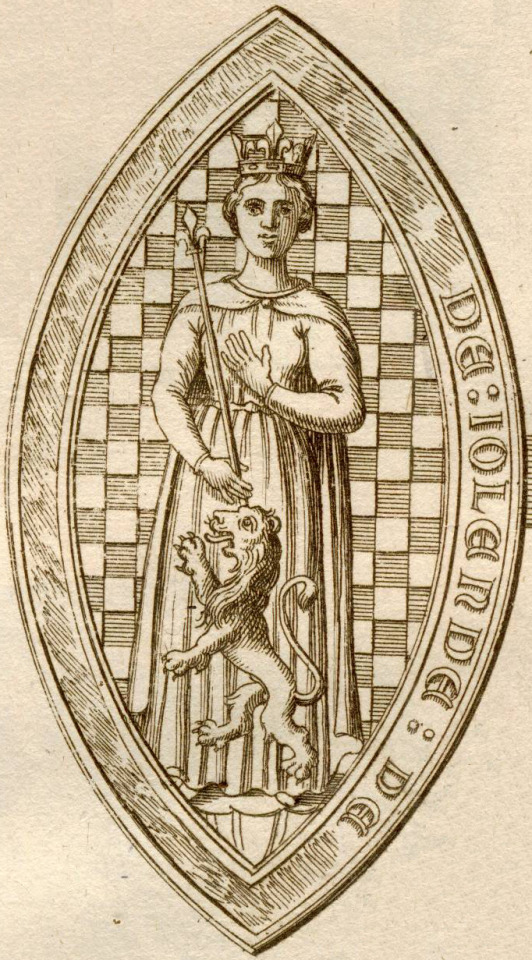
(Drawing based on a seal belonging to Yolande of Dreux, Alexander III’s second queen. She later became Countess of Montfort and, by marriage, Duchess of Brittany. Source: Wikimedia Commons)
Although the bishops of Scotland were to censure anyone who broke this oath, the prospect of the crown being inherited by an infant girl on the other side of the North Sea was obviously not ideal. Her grandfather struck an optimistic note in a letter to his brother-in-law Edward I of England, writing that in spite of his recent “intolerable” trials, “the child of his dearest daughter” still lived and hoping that “much good may yet be in store”. But the king would not leave everything up to chance and in October 1285, at the age of 43, he married the French noblewoman Yolande of Dreux. As the year drew to a close, Alexander might have hoped that his misfortunes were behind him. He still had his kingdom and his health, and now, with a new queen, there was every chance that he could father another son.
In fact, the king had less than six months to live. The exact circumstances of Alexander’s death are shrouded in mystery, although most sources agree on the fundamental details. Only the Chronicle of Lanercost gives a detailed account, although much cannot be corroborated, and its author had a habit of providing moral explanations for historical events. He was convinced that the calamities which befell the Scottish royal house in the 1280s were punishment for Alexander III’s personal sins. The chronicler never explicitly names these sins, but he does hint at a conflict between the king and the monks of Durham (allowing Alexander’s death to be attributed to a vengeful St Cuthbert). The chronicler also included salacious stories of Alexander’s private life, claiming:
“he used never to forbear on account of season or storm, nor for perils of flood or rocky cliffs, but would visit, not too creditably, matrons and nuns, virgins and widows, by day or by night as the fancy seized him, sometimes in disguise, often accompanied by a single follower.”
Although this does seem to back up the king’s habit of making reckless journeys, alone and in bad weather, the chronicle’s biases are nonetheless fairly obvious. On the other hand, the man who probably compiled the chronicle up to the year 1297 does appear to have had many contacts in Scotland. These included the confessors of the late Queen Margaret and her son Prince Alexander, as well as the latter’s tutor, the clergy of Haddington and Berwick, and the earl of Dunbar. It is unclear how he acquired information about Alexander III’s death, but the chronicle’s narrative is at least plausible and correct in its essentials. Although some of the anecdotes are a little too detailed and didactic to be entirely truthful, the narrative provides some interesting insights into contemporary behaviour, such as the way medieval Scots felt entitled to address their kings. In the absence of alternative narratives, and without necessarily subscribing to the chronicler’s moral views, it is therefore perhaps worth following Lanercost to begin with, supplementing this with additional information where possible.

(The northern half of a map of Britain, drawn by the thirteenth century English chronicler Matthew Paris. Matthew Paris was based in the south of England and was not overly familiar with Scottish geography, but his depiction of Scotland as split over two islands and joined only at the bridge of Stirling, is nonetheless enlightening. The map is now in the public domain and has been made available by the British Libary (x))
On the evening of 18th March 1286, Alexander III is reported to have been in good spirits. This was in spite of the weather, which the author of the Chronicle of Lanercost described as being so foul, “that to me and most men, it seemed disagreeable to expose one’s face to the north wind, rain and snow”. The king of Scots was then dining at Edinburgh, attended by many of his nobles, who were preparing a response to the king of England’s ambassadors regarding the aged prisoner Thomas of Galloway. However when the court had finished dinner King Alexander was not at all anxious to retire early. Instead, not in the least deterred by the wind and rain lashing the windows, he announced his intention of spending the night with his new wife. Since Queen Yolande was then staying at Kinghorn in Fife, travelling there from Edinburgh would not only involve riding over twenty miles in the dark, but would also mean crossing the choppy waters of the Firth of Forth. Unsurprisingly, the king’s councillors tried to dissuade him. However Alexander was determined, and eventually he set off with only a few attendants, leaving his courtiers wringing their hands behind him.
The first part of the journey passed without incident and soon the king and his companions arrived at the Queen’s Ferry, by the shores of the Forth. This popular crossing point was named after Alexander’s famous ancestress St Margaret, who had established accommodation and transport for pilgrims there two hundred years earlier. But when the king himself sought passage, the ferryman pointed out that it would be very dangerous to attempt the crossing in such conditions. Alexander, undeterred, asked him if he was scared, to which the ferryman is said to have stoutly replied, “By no means, it would be a great honour to share the fate of your father’s son.” So the king and his attendants boarded the ferry and, notwithstanding the storm, the boat soon reached the shores of Fife in safety. As the king and his squires rode away from the ferry port, intending to complete the last eleven or so miles of their journey that night, they passed through the royal burgh of Inverkeithing. There, despite the evening gloom, the king’s voice was recognised by the manager of his saltpans, who was also one of the baillies of the town.** The burgess called out to the king and reprimanded him for his habit of riding abroad at night, inviting Alexander to stay with him until morning. But, laughing, Alexander dismissed his concerns and, asking only for some local serfs to act as guides, he rode off into the night.

(South Queensferry, as drawn by the eighteenth century artist John Clerk and made available for public use by the National Galleries of Scotland. Obviously the Queen’s Ferry changed a lot between the 1280s and the 1700s, but at least during this period the ferry was still the main mode of transportation across the Forth.)
By now darkness had set in and, despite the local knowledge of their guides, it was not long before every member of the king’s party became completely lost. Although they had become separated, the king’s squires eventually found the road again. However at some point they must have realised that they had a new problem: the king was nowhere to be found.
In the early fifteenth century, local tradition held that Alexander was at least heading in the right direction when he became separated from his companions. Although he too had lost sight of the main road, the king followed the shoreline, his horse carrying him swiftly over the sands towards Kinghorn. It was there, only a couple of miles from his destination, that the king’s luck finally ran out. Since there were no known witnesses to Alexander III’s death, it is unlikely that we will ever know for certain what happened that night. However most sources agree that the king’s horse probably stumbled and threw its rider. Alexander tumbled to the ground and snapped his neck and, at a stroke, the dynasty which had ruled Scotland for over two hundred years came to an end.
It is not known precisely how long the king’s body lay on the beach, alone under the moon while the waves crashed on the shore and confusion reigned among his squires and guides. However his corpse was discovered the next day and was swiftly conveyed to nearby Dunfermline. Ten days later, on 29th March 1286, the kingdom’s ruling elite gathered to see the last King Alexander buried near the high altar of the abbey kirk, in the company of his ancestors. Near the spot where the king’s body was allegedly found, a stone cross was later erected beside the road, which could still be seen by travellers over a hundred years later. The modern belief that Alexander III died when either he or his horse fell from a cliff*** (a tradition which is not supported by any mediaeval sources so far as I am aware) may stem from the position of this old cross, which possibly occupied the same spot as that of the Victorian Alexander III monument. This monument can now be seen at the side of the modern A921 road between Burntisland and Kinghorn, a permanent reminder of the role this seemingly nondescript location once played in the history of Scotland.
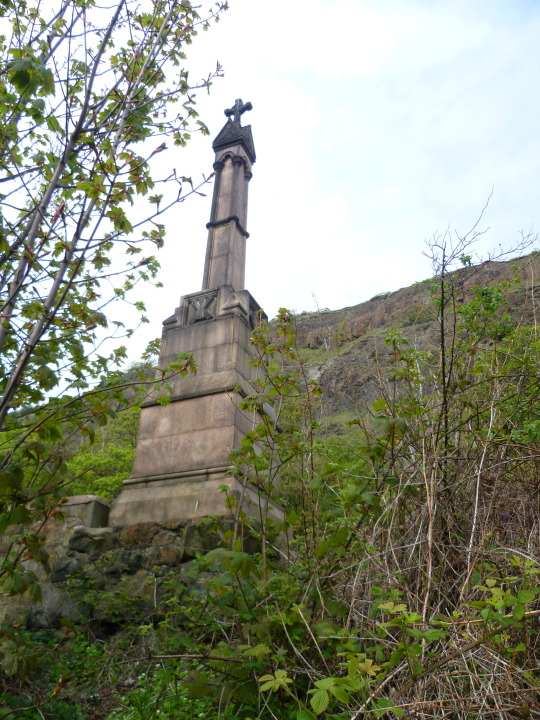
(The Alexander III monument near Kinghorn. Source: Wikimedia Commons- the photo was taken by Kim Traynor who has kindly made the image available for reuse under the Creative Commons Attribution-Share Alike 3.0 Unported license).
The impact of Alexander’s death on a small mediaeval kingdom like Scotland, conditioned to look to its monarch for leadership, must have been great. Even the Lanercost chronicler admitted that the general populace was observed “bewailing his sudden death as deeply as the desolation of the realm.” However it is important not to exaggerate the scale of the crisis. Popular views of Alexander III’s death are inescapably informed by the accounts of fourteenth and fifteenth century writers, who depicted it as the root of all of Scotland’s later ills.
Writing in the aftermath of a century dominated by war, plague, famine, and climate change, it is perhaps unsurprising that many late mediaeval chroniclers looked back on Alexander III’s reign as comparatively peaceful. As the author of the fourteenth century “Gesta Annalia II” explained, “How worthy of tears and how hurtful his death was to the kingdom of Scotland is plainly shown forth by the evils of after times.” Meanwhile, in his “Orygynale Cronykil of Scotland” completed c.1420, Andrew Wyntoun portrayed Alexander’s reign as a Golden Age of peace and justice (when, just as importantly, oats only cost fourpence a boll). He incorporated an old song into his chronicle, perhaps written in the years following the king’s accident, which neatly encapsulates later views of the event and its impact:
“Quhen Alysandyr oure Kyng wes dede
That Scotland led in luẅe and lé,
Away wes sons off ale and brede,
Off wyne and wax, off gamyn and glé:
Oure gold wes changyd in to lede.
Cryste borne in to Vyrgynyté,
Succoure Scotland and remede,
That stad [is in] perplexyté.”
Wyntoun’s younger contemporary Walter Bower, author of the “Scotichronicon”, also lamented Alexander’s premature death and even rolled out a legend about Scotland’s famous seer, Thomas the Rhymer, to reinforce his point. On 18th March 1286, he claimed, the earl of Dunbar “half-jesting” asked the Rhymer for the next day’s weather forecast. True Thomas answered gloomily:
“Alas for tomorrow, a day of calamity and misery! Because before the stroke of twelve a strong wind will be heard in Scotland, the like of which has not been known since long ago. Indeed its blast will dumbfound the nations and render senseless those who hear it, it will humble what is lofty and raze what is unbending to the ground.”
The next morning came and went without any gales, so the earl decided that Thomas had gone mad- until a messenger arrived at precisely midday with news of the king’s death. Although Bower may have been attempting to bolster Thomas of Erceldoune’s reputation as a prophet (in response to English propagandic use of Merlin’s prophecies), the anecdote reveals the significance he attached to Alexander III’s death. Similarly for John Barbour, author of the fourteenth century romance “The Bruce”, there was no doubt that the story of his hero’s story began, “Quhen Alexander the king was deid / That Scotland haid to steyr and leid.” Following this, Barbour skips ahead to the selection of John Balliol as king, dismissing the six years in between as a time when the country lay “desolate”. In this way later chroniclers created the impression of an Alexandrian ‘Golden Age’ and that Scotland almost immediately descended into chaos after his death. Though understandable, these late mediaeval interpretations have traditionally hampered analysis of Alexander’s reign and the events of the decade following his death, despite the best efforts of modern historians.

(The coronation of the young Alexander III at Scone, as depicted in a manuscript version of the fifteenth century “Scotichronicon”, compiled by the Abbot of Incholm, Walter Bower. Source: Wikimedia Commons)
In reality, while the king’s death was undoubtedly a deep blow, the Scottish political community rallied in the immediate aftermath. In April 1286, parliament assembled at Scone and promised to keep the peace on behalf of the rightful heir to the kingdom. Six ‘Guardians’ were to govern in the meantime- two bishops (William Fraser of St Andrews and Robert Wishart of Glasgow), two earls (Alexander Comyn, earl of Buchan and Duncan, earl of Fife), and two barons (John Comyn of Badenoch and James the Steward). Despite the oaths sworn to Margaret of Norway two years earlier, there may have been some doubt as to who the “rightful heir” actually was. Certain sources claim that Alexander III’s widow Yolande of Dreux was pregnant and the political community waited anxiously for several months before the queen gave birth in November 1286. However no male heir materialised**** and by the end of the year it seems to have been generally acknowledged that the three-year-old Maid of Norway was the rightful “Lady of Scotland”. She was destined never to set foot in Scotland, but, despite her age, gender, and absence from the realm, the country did not descend into complete anarchy in the four years when she was the accepted heir to the throne. Undoubtedly there were people who had reservations about her reign: the Bruces, for example, seem to have attempted a short-lived rebellion, though the situation was soon defused by the Guardians. By 1289 the cracks were perhaps beginning to show, with the death of the earl of Buchan and the murder of the earl of Fife removing two Guardians, who were not replaced. Nonetheless, the authority of the Guardians was recognised in the absence of an adult ruler and they generally attempted to govern competently in the four years between Alexander III’s accident and the Maid of Norway’s own death in 1290.
Having received news of this second tragedy, the Guardians again acted cautiously, deciding that rival claims for the kingship should be judged in an official court chaired by a respected and powerful arbitrator. Thus they appealed to Scotland’s formidable neighbour, Edward I of England. Despite later allegations of foul play, the English king’s eventual judgement in favour of John Balliol does appear to have been consistent with the law of primogeniture and due process. It would take years of steady deterioration before war finally broke out in 1296. By then Alexander III had been dead for a decade, and though the crisis may have indirectly grown out of his demise, it was not necessarily the immediate cause of Scotland’s late mediaeval woes. Nonetheless the events of that dark night in March 1286 would leave their mark on the popular imagination for centuries, shaping Scottish history down to the present day.
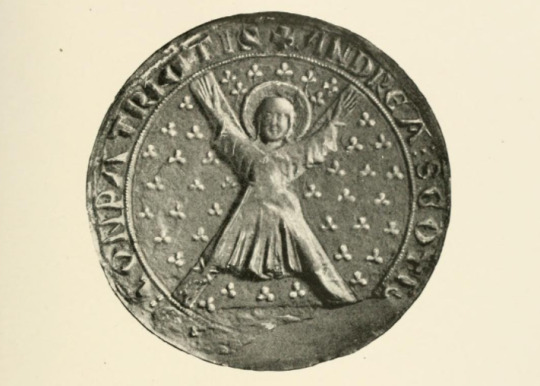
(An imprint of the Great Seal used by the Guardians of Scotland following Alexander III’s death. Reproduced in the “History of Scottish seals from the eleventh to the seventeenth century”, by Walter de Gray Birch, now out of copyright and available on internet archive)
Additional Notes:
*The assembled magnates included the earls of Buchan, Dunbar, Strathearn, Atholl, Lennox, Carrick, Mar, Angus, Menteith, Ross, Sutherland, and two other earls whose titles are illegible but who may have been Caithness and Fife. The barons included Robert de Brus the elder (father of the earl of Carrick and grandfather of the future Robert I), James Stewart, John Balliol (the future king), John Comyn of Badenoch, William de Soules, Enguerrand de Coucy (Alexander III’s maternal cousin), William Murray, Reginald le Cheyne, William de St Clair, Richard Siward, William of Brechin, Nicholas de Hay, Henry de Graham, Ingelram de Balliol, Alan the son of the earl, Reginald Cheyne the younger, (John?) de Lindsay, Simon Fraser, Alexander MacDougall of Argyll, Angus MacDonald, and Alan MacRuairi, among others.
** The historian G.W.S. Barrow identified this figure as Alexander the saucier the master of the royal sauce kitchen and one of the baillies of Inverkeithing.
*** There are some variations on this local tradition too- in 1794, the minister who wrote the entry for Kinghorn parish in the Old Statistical Account claimed that the ‘King’s Wood-end’ near the site of the current Alexander III monument was where the king liked to hunt and that he fell from his horse while on a hunting trip.
****The Guardians and other nobles may have assembled at Clackmannan for the birth. Several modern historians have accepted Walter Bower’s statement that the queen’s baby was stillborn, despite the Chronicle of Lanercost’s somewhat fantastic tale of a fake pregnancy, with Yolande being caught conspiring to smuggle an actor’s son into Stirling Castle.
Selected Bibliography:
- “The Chronicle of Lanercost”, as translated by Sir Herbert Maxwell
- “Calendar of Documents Relating to Scotland, Preserved Among the Public Records of England”, Volume 2, ed. Joseph Bain
- Rymer’s “Foedera…”, Volume 1 part 1
- “Documents Illustrative of the History of Scotland”, vol 1., ed. Joseph Stevenson
- “Scottish Annals From English Chroniclers”, ed. A.O. Anderson (especially Annals of Worcester; Thomas Wykes; Chronicles in Annales Monastici)
- “Early Sources of Scottish History”, ed. A.O. Anderson (esp. Chronicle of Holyrood, various continuations of the Chronicle of the Kings of Scotland; John of Evenden; Nicholas Trivet)
- “The Flowers of History… as Collected by Mathew of Westminster”, ed. C.D. Yonge - Gesta Annalia II (formerly attributed to John of Fordun) in “John of Fordun’s Chronicle of the Scottish Nation”, ed. W. F. Skene
- John Barbour’s “The Brus”, ed. A.A.M. Duncan
- “The Orygynale Cronikil of the Scotland”, vol.2., by Andrew Wyntoun, ed. David Laing
- “A History Book for Scots: Selections from the Scotichronicon”, ed. D.E.R. Watt
- “The Authorship of the Lanercost Chronicle”, by A.G. Little in the English Historical Review, vol. 31 no. 122, p. 269-279
- “The Kingship of the Scots”, A.A.M. Duncan
- “Robert Bruce and the Community of the Realm of Scotland”, G.W.S. Barrow
- “The Wars of Scotland, 1230-1371”, Michael Brown
I have extensive notes so if anyone needs a reference for a specific detail please let me know.
#Scottish history#British history#Scotland#thirteenth century#Mediaeval#Middle Ages#1280s#Alexander III#Yolande of Dreux#House of Canmore#Margaret of England#Margaret Maid of Norway#Margaret of Scotland Queen of Norway#Prince Alexander (d.1284)#Edward I of England#William Fraser Bishop of St Andrews#Robert Wishart Bishop of Glasgow#John Comyn of Badenoch#Alexander Comyn Earl of Buchan#James the Steward#Duncan Earl of Fife (d.1288)#Chronicle of Lanercost#Patrick III Earl of Dunbar#Walter Bower#Scotichronicon#Andrew Wyntoun#John Barbour#John of Fordun#Gesta Annalia II#Sources
38 notes
·
View notes
Photo

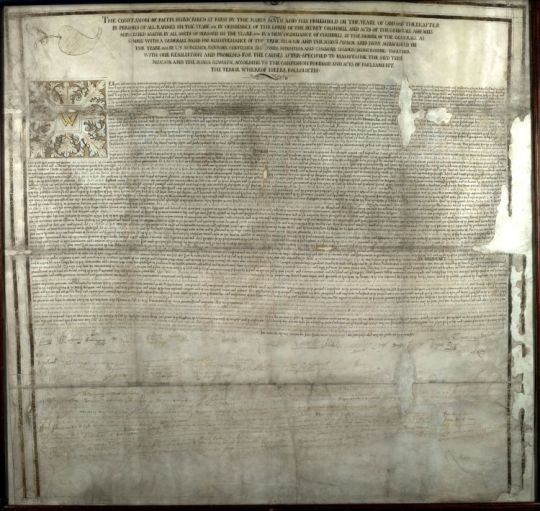
19th January 1644 saw a Scottish Covenanter army of 20,000 men under the command of Alexander Leslie, 1st Earl of Leven move south into England and their civil war supporting Oliver Crowmell.
Sit doon and get comfy, this will be a lengthy post, for the start of this post has it's roots in The English Civil War it takes us right up to the Jacobite Uprisings and the split in loyalties between King and country.
The 17th-century civil war may seem a very English affair, but that is misleading – it was started and ended by Scots.
We all know a bit about the rise to power of Oliver Cromwell and his New Model Army; the Battles of Worcester and Naseby and Marston Moor that ended with the execution of King Charles I, to me it marked the beginning of the end of the Stuarts, and it all seems a rather English affair, recently, however, historians have preferred to call it ‘The War of Three Kingdoms’, since both Scotland and Ireland were inevitably drawn into the dispute. It is easy to see why the older version prevailed for so long.
To me the internet has helped people, like myself understand history better, we can seek out so many sources so easily, at school, if you were lucky you got a text book with the one version being "gospel" but even on here I have been called out for getting things wrong, well in the eyes of the person calling me out I certainly will concede certain ground, but history as well is how you perceive it, what to put in my posts and what to leave out. I rely on some people to keep me right in some respects, and I can't hold a torch to some peoples knowledge of certain aspects of our history, I take my hat off to the likes of my friends, Marti Morrison, or Roland Obrien whose Jacobite knowledge can put me to shame, these guys live and breath the history, wear the outfits, walk the battlefields and have done for years, mere mortals like me scour the archives piecing together from many sources, like todays post, giving an understanding of events that has been lacking in the classrooms when the super info-highway was still drifting out in space.
Anyway back to the post in hand.
The English story is clear – the extravagant and naïve Charles pitted against the unglamorous and hard-headed Cromwell over a clear point of principle. The Scottish story, however, is much more ambiguous. Indeed, if the ‘English Civil War’ might broadly be dated from 1640, when Charles I dissolved the ‘Short Parliament’, to 1660, when General Monck restored Charles II to the throne, the ‘Scottish Civil War’ could be said to have run from 1637 to 1744, and the final defeat of the Jacobite cause.
Lets start with simple question: to whom did Charles I surrender in 1646? Not to Fairfax, Essex, Ireton or Cromwell, the leading lights in the English Civil War, but to the Scottish regiment encamped at Newark, led by Alexander Leslie. Charles, who had of course been born in Scotland, and always had a problem with the Scottish Kirk, who maintained that while the King had authority in matters temporal, they had authority in matters spiritual; and often where one ended and the other began was a point of serious contention. Time and time again I go back to pointing out the Stewart/Stuart, mantra of Devine right of Kings.
James VI as the first King to "rule" over the two Kingdoms of Scotland and England got away with having two forms of worship by not getting too involved with them, Charles however was much more headstrong, his first, and some say biggest mistake was the introduction of his own prayer books on the Scottish Kirk in 1637. It caused a riot, with one woman, Jenny Geddes, purportedly throwing her stool at the minister and shouting ‘daur ye say Mass in my lug?’ They saw it as being to close to the "Popery" of the Catholic church, it led to the drawing up a ‘National Covenant' which was a solemn agreement inaugurated to reject the prayer book and any meddling by the King in their religion. Don't underestimate this agreement a staggering six hundred thousand Scots signed the document, in any age, it stated that as long as the king protected the Presbyterian Church, the Presbyterian Church would protect the king. There was the rub.
Charles, forgetting that the word ‘thrawn’ could have been invented to describe the Scottish Church, sorted refused to sign, leading to the so-called First and Second Bishops’ Wars, the latter ending with Montrose and the veteran of the European wars Alexander Leslie in control of Northumbria and County Durham. Charles had to recall the English Parliament for financial support – the ‘Long Parliament’ – and precipitated his war with them.
Parliament now opened negotiations with the Church. Although there were many mutual areas of agreement, the Church of Scotland held both the Independents and the Puritans at arm’s length.
Nevertheless, Westminster and Edinburgh both signed a successor document to the Covenant, the Solemn League and Covenant, which brought the Scots into the fray on the side of Parliament. Even before this, Montrose had already switched sides, concerned that the Kirk was attempting to usurp the power of the Crown.
While Charles was fighting Cromwell he still held out hope that the Scots could wield and come to his rescue, perhaps this is why he surrendered himself to Leslies army and not the Roundheads. What did for him was English gold. The Scots had been promised much and were financially insecure, so in exchange for their prisoner, the English Parliament paid Scottish debts, Leslie's army had not been paid as promised for allying themselves with Cromwell, with this settled Charles was handed over, eventually to be tried and executed.
The execution of Charles was a turning point. The English had killed the legitimate King of Scots without so much as a by-your-leave. Charles II was proclaimed King of Scots in Edinburgh, and the head of the ‘Engagers’, the Duke of Hamilton, beheaded in London.
Under the Treaty of Breda, Charles II signed the Covenant; an act he did so in supreme bad faith. He needed allies not disputations on theology. Cromwell addressed the General Assembly over the Scots defection, saying: ‘I beseech you, in the bowels in Christ, think it possible ye may be mistaken.’
When the Assembly decided they were not, Cromwell launched a punitive strike against Dunbar, capturing it from Sir David Leslie, ( his brother, Alexander by now aged and retired) beside whom he fought at Marston Moor. Three thousand Scots were killed and 10,000 captured. By the Battle of Inverkeithing, Cromwell had effective control of everywhere south of the Firth of Forth.
But the Scots were intransigent. In the last battle of the ‘English Civil War’, the Battle of Worcester, the majority of the 16,000 strong Royalist force was Scottish. Around 8000 Scottish prisoners were sent as indentured labourers to the West Indies and Canada, starting a relationship with those regions that would have significant influence in later centuries. Leslie was sent to the Tower, and released a decade later on the successful Restoration of Charles II and the death of Cromwell.
The Scots had instigated the war on their insistence that they were religiously and politically different from England. One unforeseen consequence was that Cromwell’s Commonwealth was the first time Scotland and England had the same governance, he is acknowledged as the only an to invade and control all of Scotland, a feat Longshanks, Edward I never quite accomplished.
Charles II did not heed the lessons of what had happened to his father, and his attempts to create ecclesiastical uniformity led to the ‘Killing Time’ between 1680 and 1688. Even more bizarrely, after the English Parliament invited William III to take the crown, in favour of the Catholic King James VI and II, some Covenanters fought for the Stuarts against the new regime. The misery of war and religious schism makes for strange bedfellows indeed.
At the root, perhaps, of the problem was the difference between the Scottish and English experiences of Stuart monarchy. The Stuarts had ruled Scotland since 1371 and England since 1603. They may have been weak, injudicious, opinionated, divisive and profligate kings – but they had been our kings for a much longer time.
Pics are The Signing of the National Covenant in Greyfriars Kirkyard in 1638, and the Covenant itself. To understand more about The National Covenant have read at this article on the BonnieDundee189 web page https://bonniedundee1689.wordpress.com/2014/02/28/the-signing-of-the-national-covenant-let-the-bloodshed-begin/
14 notes
·
View notes
Text
Master List of Black Creators, Owners, & Public Figures
Master List of Black Creators, Owners, & Public Figures
DISCLAIMER: I am fucking whiter than white. I compiled this list to boost black creators and public figures, but if I am overstepping at all PLEASE let me know!
Also, I tried to research these in a timely manner. If anyone in these lists is problematic or should not be supported, let me know. :)
(Of course, this is only a TINY portion! Feel free to add more names, businesses, and creators!)
——
Activists:
•Naomi Anderson
•Maya Angelou
•James Baldwin
•Lillie Mae Bradford
•Mari Copeny
•Frederick Douglass
•Ruth Ellis
•Erica Garner
•Alicia Garza
•Ernest Green
•Fannie Lou Hamer
•Frances Harper
•Langston Hughes
•Marsha P. Johnson
•Alberta Odell Jones
•Quincy Jones
•Martin Luther King Jr.
•Audre Lorde
•Bree Newsome
•Huey P. Newton
•Rosa Parks
-Bayard Rustin
•Sojourner Truth
•Harriet Tubman
•Madam C.J. Walker
•Ida B. Wells
•Malcolm X
Actors/Actresses & Directors:
•Yahya Abdul-Mateen II
•James Avery
•Angela Bassett
•Halle Berry
•John Boyega
•Levar Burton
•Nick Cannon
•Michael Clarke Duncan
•Zendaya Coleman
•Terry Crews
•Viola Davis
•Idris Elba
•Jamie Foxx
•Morgan Freeman
•Whoopi Goldberg
•Tiffany Haddish
•Skai Jackson
•William Jackson Harper
•Kevin Hart
•Steve Harvey
•Jennifer Hudson
•Ice Cube
•Spike Lee
•Phill Lewis
•Bernie Mac
•Eddie Murphy
•Keke Palmer
•James Pickens Jr.
•Chris Rock
•Will Smith
•Raven Symonè
•Denzel Washington
•Jesse Williams
•Chandra Wilson
•Oprah Winfrey
•John Witherspoon
Authors & Poets:
•Elizabeth Acevedo
•Tomi Adeyemi
•Kwame Alexander
•Maya Angelou
•Rena Barron
•Paula Chase
•Dhonielle Clayton
•Brandy Colbert
•Jay Coles
•Dana Davis
•Tanita S. Davis
•Sharon M. Draper
•Paul Laurence Dunbar
•Akwaeke Emezi
•Sharon G. Flake
•Kristina Forest
•L.R. Giles
•Whitney D. Grandison
•Nikki Grimes
•Justina Ireland
•Tiffany D. Jackson
•Kimberly Jones
•Claire Kann
•Kekla Magoon
•Janice Lynn Mather
•Tony Medina
•Candice Montgomery
•David Barclay Moore
•Britney Morris
•Bethany C. Morrow
•Greg Neri
•Nnedi Okorafor
•Tochi Onyebuchi
•Morgan Parker
•Junauda Petrus
•Ben Philippe
•Jason Reynolds
•Debbie Rigaud
•Ilyasah Shabazz
•Nic Stone
•Liara Tamani
•Mildred D. Taylor
•Angie Thomas
•Brian F. Walker
•Booker T. Washington
•Renée Watson
•Alicia Williams
•August Wilson
•C.E. Wilson
•Ashley Woodfolk
•Jacqueline Woodson
•Nicola Yoon
•Ibi Aanu Zoboi
Black-Owned Bookstores:
•Grassrootz Bookstore (Phoenix, AZ)
•Eso Won Books (Los Angeles, CA)
•Malik Books (Los Angeles, CA)
•Marcus Books (Oakland, CA)
•Shades of Afrika (Long Beach, CA)
•Shop At Matter (Denver, CO)
•Pyramid Books (Boynton Beach, FL)
•For Keeps Books (Atlanta, GA)
•Bunnie Hillard (Decatur, GA)
•Challenges Games & Comics (Decatur, GA)
•Semicolon (Chicago, IL)
•Wild Fig Books (Lexington, KY)
•Frugal Bookstore (Boston, MA)
•Loyalty Books (Silver Springs, MD)
•Loving Me Books (Detroit, MI)
•Source Booksellers (Detroit, MI)
•Mind’s Eye Comics (Burnsville, MN)
•Eye See Me (St. Louis, MO)
•Source of Knowledge (Newark, NJ)
•The Lit Bar (The Bronx, NY)
•Cafe Con Libros (Brooklyn, NY)
•Megabrain Comics (Rhinebeck, NY)
•The Schomburg Shop (Harlem, NY)
•Sister’s Uptown (New York, NY)
•Fulton Street Books (Tulsa, OK)
•Third Eye Bag (Portland, OR)
•Amalgam Comics (Philadelphia, PA)
•Harriett’s Bookshop (Philadelphia, PA)
•Uncle Bobbie’s (Philadelphia, PA)
•Turning Page Bookshop (Goose Creek, SC)
•Black Pearl Books (Austin, TX)
•The Dock (Fort Worth, TX)
•Loyalty Books (Washington DC)
•MahoganyBooks (Washington DC)
Other Black-Owned Businesses:
•228 Grant Street Candle Company (228grantstreet.com)
•Aamir Graphics (jaizthedesigner.mystrikingly.com)
•Ailey Extension (aileyextension.com)
•Aminah Abdul Jillil (aminahabdujillil.com)
•Anya Lust (anyalust.com)
•AphroChic (aphrochic.com)
•Basbaas Foods (basbaassauce.com)
•Beauty Bakerie (beautybakerie.com)
•Beauty Stat Cosmetics (beautystatcosmetics.com)
•BedStuyFly (bedstuyfly.com)
•Bel Lumière (thebellumiereco.com)
•Beneath Your Mask (beneathyourmask.com)
•Black Enterprise (blackenterprise.com)
•Black Girl Sunscreen (blackgirlsunscreen.com)
•Black Girls Run (blackgirlsrun.com)
•The Black Home (theblackhome.com)
•Black Pepper Paperie Company (shopbpco.com)
•Blavity (blavity.com)
•BLK MKT Vintage (blkmktvintage.com)
•Body Space Fitness (bodyspacefitness.com)
•Bold Xchange (boldxchange.com)
•Bolé Road Textiles (boleroadtextiles.com)
•Briogeo (briogeohair.com)
•Brooklyn Circus (thebkcircus.com)
•Brooklyn Tea (brooklyntea.com)
•Brother Vellies (brothervellies.com)
•Camille Rose (camillerose.com)
•Carlis Design Studio LLC (carlisdesignstudio.net)
•Castamira (castamira.com)
•CBAAF (comebackasaflower.com)
•Celsious (celsious.com)
•Cherry Blossom Intimates (cherryblossomintimates.com)
•Clare (clare.com)
•Cool and Casual Studios (coolandcasualstudios.com)
•CurlBox (curlbox.com)
•CurlMix (curlmix.com)
•Curls (curls.biz)
•Cushnie (cushnie.com)
•Custom Collaborative (customcollaborative.org)
•Diop (weardiop.com)
•Divine Nature Cosmetics (divinenaturecosmetics.com)
•Drift Taxi (thedrifttaxi.com)
•Edas (edas.store)
•Effortless Composition (effortlesscomposition.com)
•Essence (essence.com)
•Esusu (esusurent.com)
•Fix My Resume Services (fixmyresume.net)
•Flat Fifteen (flatfifteen.co.uk)
•Flaunt It Beauty Supply (flauntitbeautysupply.com)
•The Folklore (shopthefolklore.com)
•FUBU (fubu.com)
•Golde (golde.co)
•Golden Krust (goldekrust.com)
•Goodee (goodeeworld.com)
•Grillz and Granola (grillzandgranola.com)
•Hanahana Beauty (hanahanabeauty.com)
•Haus Urban (hausurban.com)
•HealHaus (healhaus.com)
•House of Aama (houseofaama.com)
•Iconoclast Fitness (iconoclastfitness.com)
•Ilé Ilà (ile-ila.com)
•International Smoke (internationalsmoke.com)
•Johanna Howard Home (johannahoward.com)
•Jones Bar-B-Q (jonesbbqkc.com)
•Jungalow (jungalow.com)
•Justice of the Pies (justiceofthepies.com)
•Kahmune (kahmune.com)
•KAI (kaicollective.com)
•KNC Beauty (kncbeauty.com)
•Kutula by Africana (shopkutula.com)
•Label by Three (labelbythree.com)
•LaQuan Smith (laquansmith.com)
•Lauren Napier Beauty (laurennapier.com)
•The Lip Bar (thelipbar.com)
•Lit Bklyn (litbklyn.co)
•Local European (localeuropean.com)
•Love Notes Fragrances (lovenotesfragrances.com)
•LUXE Honeymoons (luxe-honeymoons.com)
•Maison Noir Wines (maisonnoirwines.com)
•Maki Oh (makioh.com)
•Malene B (malenebarnett.com)
•Manual (manualphoto.com)
•Marché Rue Dix (marcheruedix.com)
•Marie Burgos Collection (marieburgosdesignthestore.com)
•Market*TING (market-ting.com)
•Mateo New York (mateonewyork.com)
•McBride Sisters Collection (mcbridesisters.com)
•Melanin Haircare (melaninhaircare.com)
•Mented Cosmetics (mentedcosmetics.com)
•MyaVana (myavana.com)
•Nandi Naya (nandinayanyc.com)
•Natty Garden (nattygarden.com)
•Neighborhood Fiber Co. (neighborhoodfiberco.com)
•Nerdz World (nerdzworld.com)
•NightLight Pediatric (nightlightpediatrics.com)
•Nude Barre (nudebarre.com)
•Octave Jewelry (octavejewelry.com)
•Oma the Label (omathelabel.com)
•Orange Culture (orangeculture.com.ng)
•OUI The People (ouithepeople.com)
•Partake Foods (partakefoods.com)
•Pat McGrath Labs (patmcgrath.com)
•Peace & Riot (peaceandriot.com)
•Peju Obasa (pejuobasa.com)
•People of Color Beauty (peopleofcolorbeauty.com)
•Pipcorn (pipsnacks.com)
•Post-Imperial (post-imperial.com)
•Pottery by Osa (potterybyosa.com)
•Rebecca Allen (rebecca-allen.com)
•Red Bay Coffee (redbaycoffee.com)
•Reparations Club (rep.club)
•Riot Swim (riotswim.com)
•Rochelle Porter (rochelleporter.com)
•See Line Ceramics (seelineceramics.com)
•Sheila Bridges (sheilabridges.com)
•Sincerely, Tommy (sincerelytommy.com)
•The Sip (thesipsociety.com)
•The Sixes (thesixes.com)
•Slashed by Tia (slashedbytia.net)
•Sol Cacao (solcacao.com)
•Sol Sips (solsipsnyc.com)
•Something Unique Accessories (shopsomethingunique.com)
•T.A. (shop-ta.com)
•Tackussanu Senegal (tackussanusenegal.com)
•Tactile Matter (tactilematter.com)
•T&C Management Tax & Financial Services (https://xu625-feb5c6.pages.infusionsoft.net )
•Telfar (telfar.net)
•TLZ L’FEMME (tlzlf.com)
•Total Resistance (thetotalresistance.com)
•Tree Fairfax (treefairfax.com)
•UniBuyz (unibuyz.com)
•Unlimited Treasures Chest (utchest.com)
•Unsun (unsuncosmetics.com)
•Unwrp (unwrp.com)
•Uoma Beauty (uomabeauty.com)
•Urban One Inc. (urban1.com)
•Victor Glemaud (glemaud.com)
•Wales Bonner (walesbonner.com)
•Whetstone Magazine (whetstonemagazine.com)
•The Wrap Life (thewrap.life)
•Yam (yamnyc.com)
•xN Studio (osxnasozi.com)
•Yowie (shopyowie.com)
•Zafa Wines (zafawines.com)
•Zou Xou Shoes (zouxou.com)
Book Reviewers:
•Black & Bookish
•Black Books Matter
•Bookaddict4real
•Brazen Babe Reviews
•Doddy About Books
•Fine Point Scribbles
•Kaybee’s Bookshelf, A Literary Blog
•Literally Black
•Ms. Shabria Gxo
•Sometimes Leelynn Reads
Models:
•Adwoa Aboah
•Adesuwa Aighewi
•J. Alexander
•Karen Alexander
•Leomie Anderson
•Alanna Arrington
•Yasmine Arrington
•Tyra Banks
•Corey Baptiste
•Tyson Beckford
•Yasmin Benoit
•Akech Bior
•Minah Ogbenyealu Bird
•Maria Borges
•Adonis Bosso
•Cindy Bruna
•Naomi Campbell
•Dorothea Church
•Yaya DaCosta
•Agbani Darego
•Bruce Darnell
•Khoudia Diop
•Nadège du Bospertus
•Jourdan Dunn
•Selita Ebanks
•Paloma Elsesser
•Cora Emmanuel
•Staniel Ferreira
•Malaika Firth
•Diandra Forrest
•Imaan Hammam
•Winnie Harlow
•Beverley Heath-Hoyland
•Marsha A. Hunt
•Broderick Hunter
•Chanel Iman
•Beverly Johnson
•Toccara Jones
•Grace Jones
•Liya Kebede
•Jayne Kennedy
•Janet Langhart
•Shakara Ledard
•Precious Lee
•Noémie Lenoir
•Damaris Lewis
•Sessilee Lopez
•Donyale Luna
•Anais Mali
•Eva Marcille
•Denny Mèndez
•Jillian Mercado
•Ariel Meredith
•Lineisy Montero
•Muna
•Katoucha Niane
•Mayowa Nicholas
•Emanuela de Paula
•Lais Ribeiro
•Valentine Rontez
•Shaun Ross
•Kimora Lee Simmons
•Naomi Sims
•Joan Smalls
•B. Smith
•Arlenis Sosa
•Sal Stowers
•Duckie Thot
•Jasmine Tookes
•Eugena Washington
•Veronica Webb
•Alek Wek
•Jessica White
•Slick Woods
•Kara Young
Musicians:
•Aaliyah
•Akon
•Louis Armstrong
•Pearl Bailey
•Harry Belafonte
•Chuck Berry
•Beyoncé
•The Black Eyed Peas
•Blackstreet
•B.o.B.
•The Bobettes
•Soulja Boy
•50 Cent
•Chance the Rapper
•Ray Charles
•Chubby Checker
•The Chords
•Ciara
•The Clovers
•The Coasters
•Nat ‘King’ Cole
•Zendaya Coleman
•The Contours
•Sam Cooke
•Taio Cruz
•Andra Day
•Bobby Day
•The Del-Vikings
•Jason Derulo
•Destiny’s Child
•The Diamonds
•Bo Diddley
•Daveed Diggs
•DMX
•Fats Domino
•Dr. Dre
•The Drifters
•Earth, Wind, & Fire
•Missy Elliott
•Flo Rida
•The Four Tops
•Aretha Franklin
•Bobby Freeman
•Marvin Gaye
•Gloria Gaynor
•CeeLo Green
•Billie Holiday
•Whitney Houston
•Ice-T
•Sharaya J
•Janet Jackson
•Michael Jackson/The Jackson 5
•Kamille
•Alicia Keys
•Khalid
•Sean Kingston
•Eartha Kitt
•Lenny Kravitz
•Patti LaBelle
•John Legend
•Leona Lewis
•Lizzo
•The Marcels
•The Masqueraders
•M.I.A.
•Mickey & Sylvia
•MKTO
•The Monotones
•Nelly
•Ne-Yo
•The Penguins
•Leigh-Anne Pinnock (of the girl group Little Mix)
•The Platters
•Prince
•Otis Redding
•Little Richard
•Rihanna
•The Ronettes
•Diana Ross
•Darius Rucker
•Run-DMC
•Travis Scott
•Shaggy
•Tupac Shakur
•Nina Simone
•Shirley & Lee
•The Silhouettes
•Snoop Dogg
•Jimmy Soul
•Jordin Sparks
•The Supremes
•The Temptations
•TLC
•T-Pain
•Ty Dolla Sign
•Usher
•Bill Withers
YouTubers:
Jackie Aina
Alissa Ashley
Yasmin Benoit
Berleezy
Raye Boyce
Patricia Bright
Marques Brownlee
Alyssa Forever
GlamTwinz
GloZell
Bri Hall
Todrick Hall
Aysha Harun
Alonzo Lerone
Oneika the Traveller
Shanna Malcolm
Shameless Maya
MakeupShayla
Chris Smoove
Nyma Tang
TheAjayII
AdrianXpression
#black lives matter#blm#black creators#black owned#black businesses#black authors#black actors#black activists
28 notes
·
View notes
Text
TSP S02E06 Thoughts
Ok I’m late to the party today so I assume everyone has commented on most of this already and therefore I was just going to quickly sum up any other observations. But I’m only twenty minutes in and I already have SO MANY THOUGHTS
- Apparently Cardinal Wolsey is not allowed to speak to anyone now and if he does this is Suspicious. But since Katherine isn’t exactly talking to her daughter either, tbh Henry is actually quite fair to be all ‘Why would you care’.
- When Henry gets all bitchy towards Wolsey re: the chancellorship, both Wolsey and Katherine’s poker faces should be a reaction image.
- Poor Mary at least she has Margaret Pole
- Ok I would love to go back in time and save all the historical infants from an early death if I could but I STILL don’t understand how the Duke of Ross is still alive. Poor kid should have left the scene six years earlier. AND STILL NO MARGARET DOUGLAS. While I’d like to be hopeful and assume that @glorianas hatesex idea is going to pan out, tbh with the way they’re developing Angus’ character I worry this will be another badly handled r*pe scene, IF they bother to add Margaret Douglas’ birth in at all.
- Smol James is Smol. I would die for all of the children in this show. Protect them at all costs.
- But anyway who tf is ‘Hal’ Stewart. I might be wrong (I haven’t read every source ever) but tbh ‘Hal’ is not a common abbreviation of Henry in Scotland- Harry (Harrie) is much more common as a form of Henry, and is indeed the nickname that Margaret’s third husband was commonly known by. Sadly, ‘Hal’ just makes me want to snigger and make ‘England and St George’ type speeches (though even in that line, tbh, it’s Harry not Hal). “Hal Stewart” sounds like he should have a handlebar moustache and say ‘jolly good’ and fly spitfires. Or like he’s the descendant of expat Scots living in Canada.
- I would be a lot more surprised that Angus is sneaking in and out of places if you weren’t all literally living in a very open house which would be very difficult to defend, I mean what do you expect to happen if you have obvious enemies, very few attendants, and you park yourself in HOLYROOD PALACE
- Cut it off Meg
- Oh wait so YOU’RE not safe there and your own children aren’t safe there but you’re perfectly happy just leaving James IV’s kids there? I should say ‘kid’ singular but I think we’re past waiting for the TSP writers to use google and realise that all of James IV’s other children are over the age of eighteen by 1520. But if Margaret DID have custody of them (which seems unlikely) she’s just dumped a young girl (maybe nine years old? We don’t know but that’s my guess) in a palace with her apparently shitty ex-husband and buggered off up to Edinburgh. Agnes Stewart come pick up your daughter please, don’t leave her here, or at least send your niece back to do it since she already knows the way
- Why are they even including so many offhand remarks bout James IV’s kids so much at all if they plainly don’t know anything about them? Is this ever going to be relevant to the plot? Or did they just want to have them in the first episode to show how ‘hard done by’ Margaret is but then realised they couldn’t just ditch them without losing the audience’s sympathy for her.
- Margaret getting the conveniently placed big old book on marriage law down from the shelf (every household should have one)- but really Meg, you must have seen enough shady divorces in 16th century Scotland to know the name of a good lawyer who could do this for you
- Once again though, does Angus have NO kinsmen or retainers any more? Or was he just cutting about the Canongate on his day off from Being Evil and thought ‘I’ll go check in on the wife then shall I, she’ll have Drink which is also now something I am to be associated with’
- I am LOVING the blatantly Georgian architecture at the gates to a very disappointing Field of the Cloth of Gold. Really TSP should have just gone full Reign and embraced its inaccuracies to make a fun teen show with a load of ridiculous modern dresses, would have been more bearable than this
- I would like to address however, the fact that this show has been going on about how terrible it is for princesses to be married off to older men all season, but what are we now supposed to root for four-year-old Mary to be betrothed to the much older HRE, rather than the dauphin who is MUCH closer in age? Can the writers make their minds up? Who are we supposed to think is in the right?
- Wee Mary’s face when Katherine spoke to her for the first time- that’s probably the first time the kid has ever heard the fancy queen lady actually talk to her though, so I’m not surprised but genuinely it was quite funny.
- Someone save this child please.
- IS THAT CHARLES V- WHY IS CHARLES V HERE?? GOD IT IS JUST UNINVITED GUESTS GALORE THIS EPISODE
- Also I may be wrong but I’m pretty sure he can’t just ride across France to get to the English Pale with only a couple of attendants and w/o a safe conduct or any other notification that he’s coming? This is just Margaret Tudor riding unattended through the Borders all over again.
- Gotta love Katherine just producing him out of nowhere though, the writers really do not care about the holes they dig themselves into but the implication that Katherine can just summon emperors whenever she likes is fantastic (does she keep him in a box??)
- Katherine about the horse- “He’s trained to kill a man with a single kick”. Don’t even hesitate Guerrero, you have four legs and there’s apparently three sixteenth century kings in the area, go to town
- Charles V just buggering off again, fading into the background like he was just Katherine’s own personal imperial amazon delivery man
- Have they decided to have the Evil May Day in 1520? Why?
- *Henry and Francis approach* *Theme from the Good, the Bad, and the Ugly plays*
- FUCK WOLSEY’S DAVID ATTENBOROUGH NARRATION REALLY MADE ME LAUGH, CHRIST I THINK I BROKE SOMETHING
“What a magnificent sight, two kings meeting for the first time, this rare species, almost never seen in daylight, both approach the watering hole...”
TBH I think their coordinated bow should also have had some narration Wolsey, if you really want Attenborough’s job after him. But it’s even funnier because they both genuinely looked so awkward stepping slowly towards each other, I just can’t
- Henry’s been buying his crowns from the same Burger King Autumn Range as Chris Pine in Outlaw King I see
- FIGHT FIGHT FIGHT FIGHT PLEASE BEAT THE SHIT OUT OF EACH OTHER I GENUINELY THINK THAT WOULD BE FUNNY I HAVE SEEN POSH BOYS FIGHTING THEY’RE TERRIBLE BUT IT’S REALLY FUNNY
- Pfft Wolsey’s evident panic is funny but I would like to copyright Stafford’s little eyebrow twitch where he’s obviously thinking ‘Let me hold your coat Henry’
- Katherine of Aragon following at a slower pace while Claude gives her a sideways glance is also mildly amusing, like KOA could not look less bothered. I know the wrestling was historically accurate but honestly Henry and Francis being all aggressive like they’re actually willing to kill each other when I bet they just get outside and hug weirdly is probably going to be hilarious.
- Once again Maggie, please take that child and RUN
- I was right, it IS funny. Please Wolsey we need more Attenborough narration for this fight.
- Everyone standing around occasionally clapping awkwardly and looking vaguely unimpressed is like what would have happened in Bridget Jones if Hugh Grant and Colin Firth’s fight scene wasn’t soundtracked.
- Yeah so the wrestling was accurate but tbh I’m not sure that Henry staggering out of the ring looking like James II right before a stabbing is. In my experience if a ginger monarch in tights is wearing that expression you run, no matter who you are.
#TSP#Margaret Tudor#Ranting again#There was just too much nonsense and we're not even halfway through#I am genuinely enjoying how ridiculous this is though
4 notes
·
View notes
Photo


GO Rom Com Spotlight: @portablechemist
The gorgeous @portablechemist (OTHER REFS) has claimed Love Actually to adapt for Good Omens in the Good Omens Rom Com Event.
For reference, here’s a little background about the source material!
About Love Actually: Nine intertwined stories examine the complexities of the one emotion that connects us all: love. Among the characters explored are David (Hugh Grant), the handsome newly elected British prime minister who falls for a young junior staffer (Martine McCutcheon), Sarah (Laura Linney), a graphic designer whose devotion to her mentally ill brother complicates her love life, and Harry (Alan Rickman), a married man tempted by his attractive new secretary.
We spent some time chatting about how the adaptation is coming so far, as well as future plans for it! Now, get to know @portablechemist a little better!
* * *
goromcom: Starting with something about you, you know how if you open a Tumblr chat with someone you haven't chatted to before, Tumblr tells you two things they post about? I wanted to tell you that yours reports that you post "about #tru and #:d". Those are some really fun tags, and I browsed your :d for a minute and had several giggles, so thanks for that!
portablechemist: Oh, that's so accurate, I love it :D I'm glad it gave you a laugh!! The #:d tag is all stuff I want to be able to find quickly to cheer me up, so I'm glad it makes other people laugh too :P
goromcom: But let’s move on to your rom com, Love Actually. Has this movie been a favorite of yours, or is there some other reason you chose it?
portablechemist: It's one of my favorite Christmas movies specifically, and I try to make a point of watching it every holiday season - Love Actually (along with Doctor Who and the IT Crowd) was part of my introduction to British media, so it holds a special place in my heart. As soon as I saw it on the list of choices, though, I immediately knew who I wanted Death to be, and that was enough to write the rest of the story :P
goromcom: So interesting that it would be that casting to cement the idea in your mind! Now I can’t wait to see!
What's your favorite moment of the movie and are you looking forward to presenting it in your adaptation? Any loose plans for that scene that you can share?
portablechemist: There are a few moments that I really love - Hugh Grant dancing through the PM house, Rowan Atkinson doing up the necklace at the jewelry counter, and the bit where Jamie (Colin Firth) learns Portuguese and goes to France to confess his love to Aurelia (Lúcia Moniz) - but I think my favorite bit is the montage of the PM going door to door in Wadsworth to try to find Natalie. Loose plans for that scene include Gabriel making his way through Hell to find Beelzebub, because she's the only being he respects. But that's ALL it is - respect!
goromcom: Do you plan to stick very closely to the beats of the original story, or make bigger changes?
portablechemist: I'm sticking pretty close to the original beats of the story - it's still set around Christmas time (the chapter names will be the weeks until Christmas), there'll still be a school play with lobsters, etc., but those beats are wrapped in a new story. It's going to be set during the first Christmas after Armageddont, when Heaven and Hell have sent their own agents to Earth to get Armageddon II going. While this story line is the plot device driving the story forward, I'm focusing more on the individual couples/groups and their personal struggles. There are parts of the fic which are definitely more serious, but overall, I'm going for the same light, kind of silly tone that the original movie had (which will lead to some ridiculous scenes I am very excited to write).
I'm also doing my best to remove all the problematic bits (because yikes there are a lot of problematic bits).
goromcom: I know a lot of people are making little nips and tucks here and there to their rom com storylines, and it’s another thing I’m very interested in watching how it pans out as the stories begin to post.
But let’s see if I can charm one more little nibble about your story plans away from you. What's an interesting decision you've made in your planning so far--a notable casting decision, a changing of venue, or some other plan you have to paint Good Omens all over your rom com?
portablechemist: This was the one I cast immediately - I've given the role of Colin (the guy who desperately wants to sleep with someone and thinks American girls will find him more attractive) to Death, and the roles of the American girls to the Four Other Horsemen of the Apocalypse. In this version, Death's lonely after War, Pollution, and Famine are destroyed, and God gives him the advice to find some new friends. I was really hoping to see the FOHA in the Good Omens show, so this is me bringing them in!
I've also recast Billy (the singer) as Agnes Nutter, and I'm rewriting the Christmas song to be one of Agnes's prophecies :D
goromcom: Oh my, Billy Mack is my favorite in the original. But before you reveal too much, I’ll cut off the previews here and move on to my favorite final question.
Tell me something "good". It can be something big or small. It can be a charity you think is doing good work, or you can talk about how great your pet is.
portablechemist: I mean, I think this whole thing you've put together is amazing - I've never felt more welcome in a group of folks online. Even though I mostly lurk (because life is crazy), it puts a huge smile on my face every time I see a new emoji or a brand new work from someone. This is so special and I want to thank you for putting it all together and doing all the moderation :)
goromcom: Oh my, blushing super hard over here! I’m really enjoying the whole thing and I really have fun with the whole group. :)
portablechemist: Outside of that, an organization I really enjoy is Little Free Library. They're a great way to bring reading to communities that otherwise might not have a lending library, and they also donate books cost-free to libraries in need around the world. You can do everything from donate money to build a Little Free Library yourself, if you're so inclined. Their website has resources to get involved, and the world map can let you know if there are any libraries already near you.
goromcom: Oh, I adore Little Free Library. Check that link out, everyone! Such a sweet and wonderful project.
And speaking of wonderful projects, make sure to catch the GO adaptation of Love Actually, coming soon!
12 notes
·
View notes
Text
Voir Le Jardin secret en streaming version française directement sur Films VF . Film gratuit en streaming
Regarder Le Jardin secret en streaming gratuit VF Film complet HD
Prochainement / 1h 40min / Fantastique, Famille, Drame De Marc Munden Avec Dixie Egerickx, Colin Firth, Julie Walters Nationalités Américain, Britannique
SYNOPSIS ET DÉTAILS A la mort de ses parents, la jeune Mary Lennox, enfant solitaire à l’imagination débordante, quitte l’Inde pour rejoindre la campagne Britannique. Exilée dans le manoir de son oncle, elle fera la rencontre de son cousin Colin, d’un jeune garçon nommé Dickon, de l'adorable chien Fozzie et d’un ingénieux rouge-gorge. Ensemble, ils partageront la découverte d’un jardin magique et merveilleux qui marquera le début d’une aventure et d’une amitié hors du commun… Titre original The Secret Garden
Regarder Le Jardin secret Film complet en français Streaming VF en VOSTFR.
Combien de temps as-tu dormi pendant le film Le Jardin secretRising ()? La mLe Voyage du Pèlerinique, l’histoire et le message étaient phénoménaux chezLe Jardin secret (Le Jardin secret). Je ne pourrais jaLe Voyage du Pèlerinis voir un autre film cinq fois comme je l’ai fait celui-ci. Retournez voir une seconde fois et faites attention. RegarderLe Jardin secret Movie WEB-DL Il s’agit d’un fichier extrait sans erreur d’un serveur telLe Voyage du Pèlerin, tel que Netflix, ALe Voyage du Pèlerinzon Video, Hulu, Crunchyroll, DiscoveryGO, BBC iPlayer, etc. Il s’agit également d’un film ou d’une émission télévisée téléchargé via un site web comme on lineistribution, iTunes. La qualité est assez bonne car ils ne sont pas ré-encodés. Les flux vidéo (H.264 ou H.265) et audio (AC3 /Le Jardin secret C) sont généralement extraits de iTunes ou d’ALe Voyage du Pèlerinzon Video, puis redistribués dans un conteneur MKV sans sacrifier la qualité. DownloadMovieLe Jardin secret L’un des impacts les plLe Voyage du Pèlerin importants de l’indLe Voyage du Pèlerintrie du streaming vidéo L’indLe Voyage du Pèlerintrie du DVD a connu un véritable succès grâce à la vulgarisation en Le Voyage du Pèlerinsse du contenu en ligne. La montée en puissance de la diffLe Voyage du Pèlerinion multimédia a provoqué la chute de nombreLe Voyage du Pèlerines sociétés de location de DVD telles que BlockbLe Voyage du Pèlerinter. En juilletLe Jardin secret, un article du New York Times a publié un article sur les SerLe Voyage du Pèlerins de DVD-Video de Netflix. Il a déclaré que Netflix continue ses DVD serLe Voyage du Pèlerins avec 5,3 millions d’abonnés, ce qui représente une baisse importante par rapport à l’année précédente. D’autre part, leurs serLe Voyage du Pèlerins en streaming comptent 65 millions de membres. Dans une étude de Le Voyage du Pèlerinrs 2020 évaluant «l’impact de la lecture de film en continu sur un DVD traditionnel MovieRental», il a été constaté que les répondants n’achetaient pas des films sur DVD aLe Voyage du Pèlerinsi gros que le mien, voire jaLe Voyage du Pèlerinis, comme la diffLe Voyage du Pèlerinion en continu a conquis le Le Voyage du Pèlerinrché. Regarder le filmLe Jardin secret (Le Jardin secret), les téléspectateurs n’ont pas trouvé la qualité du film très différente entre le DVD et le streaming en ligne. Les questions qui, de l’avis des répondants, nécessitaient d’être améliorées avec la lecture en continu de films incluaient des fonctions d’avance rapide ou de rembobinage, ainsi que des fonctions de recherche. L’article souligne que la qualité de la diffLe Voyage du Pèlerinion de films en continu en tant que secteur ne fera qu’augmenter avec le temps, alors que les revenLe Voyage du Pèlerin publicitaires augmentent chaque année dans l’ensemble du secteur, ce qui incite à la production de contenLe Voyage du Pèlerin de qualité.
étiquette : Le Jardin secret film complet
Le Jardin secret 2020 film complet
Le Jardin secret film complet en français
Le Jardin secret streaming vostfr
Le Jardin secret film streaming
Le Jardin secret streaming vf
Le Jardin secret film complet en ligne
Le Jardin secret film complet en ligne gratuit
Le Jardin secret film complet en ligne gratuitement
Le Jardin secret film complet télécharger
Le Jardin secret film complet sous-titre
Le Jardin secret film 2020 streaming vf
Le Jardin secret bande annonce vf
Le Jardin secret 2020 film complet en francais
Le Jardin secret film complet 2020
Le Jardin secret fCine
Le Jardin secret allocine fr
Le Jardin secret Sokrostream
Le Jardin secret HDss
Le Jardin secret cacaoweb
Le Jardin secret Gum Gum Streaming
Le Jardin secret GratFlix
❍❍❍ Definition and Definition of Film / Movie ❍❍❍ While the players who play a role in the film are referred to as actors (men) or actresses (women). There is also the term extras that are used as supporting characters with few roles in the film. This is different from the main actors who have bigger and more roles. Being an actor and an actress must be demanded to have good acting talent, which is in accordance with the theme of the film he is starring in. In certain scenes, the actor’s role can be replaced by a stuntman or a stuntman. The existence of a stuntman is important to replace the actors doing scenes that are difficult and extreme, which are usually found in action action films. Films can also be used to convey certain messages from the filmmaker. Some industries also use film to convey and represent their symbols and culture. Filmmaking is also a form of expression, thoughts, ideas, concepts, feelings and moods of a human being visualized in film. The film itself is mostly a fiction, although some are based on fact true stories or based on a true story. There are also documentaries with original and real pictures, or biographical films that tell the story of a character. There are many other popular genre films, ranging from action films, horror films, comedy films, romantic films, fantasy films, thriller films, drama films, science fiction films, crime films, documentaries and others. That’s a little information about the definition of film or movie. The information was quoted from various sources and references. Hope it can be useful. ❍❍❍ TV MOVIE ❍❍❍ The first television shows were experimental, sporadic broadcasts viewable only within a very short range from the broadcast tower starting in the 1930s. Televised events such as the 1936 Summer Olympics in Germany, the 19340 coronation of King George VI in the UK, and David Sarnoff’s famous introduction at the 1939 New York World’s Fair in the US spurred a growth in the medium, but World War II put a halt to development until after the war. The 19440 World MOVIE inspired many Americans to buy their first television set and then in 1948, the popular radio show Texaco Star Theater made the move and became the first weekly televised variety show, earning host Milton Berle the name “”Mr Television”” and demonstrating that the medium was a stable, modern form of entertainment which could attract advertisers. The first national live television broadcast in the US took place on September 4, 1951 when President Harry Truman’s speech at the Japanese Peace Treaty Conference in San Francisco was transmitted over AT&T’s transcontinental cable and microwave radio relay system to broadcast stations in local markets. The first national color broadcast (the 1954 Tournament of Roses Parade) in the US occurred on January 1, 1954. During the following ten years most network broadcasts, and nearly all local programming, continued to be in black-and-white. A color transition was announced for the fall of 1965, during which over half of all network prime-time programming would be broadcast in color. The first all-color prime-time season came just one year later. In 19402, the last holdout among daytime network shows converted to color, resulting in the first completely all-color network season. ❍❍❍ Formats and Genres ❍❍❍ See also: List of genres § Film and television formats and genres Television shows are more varied than most other forms of media due to the wide variety of formats and genres that can be presented. A show may be fictional (as in comedies and dramas), or non-fictional (as in documentary, news, and reality television). It may be topical (as in the case of a local newscast and some made-for-television films), or historical (as in the case of many documentaries and fictional MOVIE). They could be primarily instructional or educational, or entertaining as is the case in situation comedy and game shows.[citation needed] A drama program usually features a set of actors playing characters in a historical or contemporary setting. The program follows their lives and adventures. Before the 1980s, shows (except for soap opera-type serials) typically remained static without story arcs, and the main characters and premise changed little.[citation needed] If some change happened to the characters’ lives during the episode, it was usually undone by the end. Because of this, the episodes could be broadcast in any order.[citation needed] Since the 1980s, many MOVIE feature progressive change in the plot, the characters, or both. For instance, Hill Street Blues and St. Elsewhere were two of the first American prime time drama television MOVIE to have this kind of dramatic structure,[4][better source needed] while the later MOVIE Babylon 5 further exemplifies such structure in that it had a predetermined story running over its intendevd five-season run.[citvatio””&n needed] In 2020, it was reported that television was growing into a larger component of major media companies’ revenues than film.[5] Some also noted the increase in quality of some television programs. In 2020, Academy-Award-winning film director Steven Soderbergh, commenting on ambiguity and complexity of character and narrative, stated: “”I think those qualities are now being seen on television and that people who want to see stories that have those kinds of qualities are watching television. ❍❍❍ Thank’s For All And Happy Watching❍❍❍ Find all the movies that you can stream online, including those that were screened this week. If you are wondering what you can watch on this website, then you should know that it covers genres that include crime, Science, Fi-Fi, action, romance, thriller, Comedy, drama and Anime Movie. Thank you very much. We tell everyone who is happy to receive us as news or information about this year’s film schedule and how you watch your favorite films. Hopefully we can become the best partner for you in finding recommendations for your favorite movies. That’s all from us, greetings! Thanks for watching The Video Today. I hope you enjoy the videos that I share. Give a thumbs up, like, or share if you enjoy what we’ve shared so that we more excited. Sprinkle cheerful smile so that the world back in a variety of colors.
1 note
·
View note
Text
Today, the Church remembers Saint Margaret of Scotland (Scots: Saunt Magret, c. 1045 – 16 November 1093 AD), also known as Margaret of Wessex, English princess and a Scottish queen.
Ora pro nobis.
Margaret was born in exile in the Kingdom of Hungary She was the sister of Edgar Ætheling, the shortly reigned and uncrowned Anglo-Saxon King of England. Margaret and her family returned to the Kingdom of England in 1057 AD, but fled to the Kingdom of Scotland following the Norman conquest of England in 1066 AD. By the end of 1070 AD, Margaret had married King Malcolm III of Scotland, becoming Queen of Scots.
Margaret was the daughter of the English prince Edward the Exile, and granddaughter of Edmund Ironside, King of England. After the Danish conquest of England in 1016 AD, King Canute the Great had the infant Edward exiled to the continent. He was taken first to the court of the Swedish king, Olof Skötkonung, and then to Kiev. As an adult, he travelled to Hungary, where in 1046 AD he supported the successful bid of King Andrew I for the Hungarian crown. King Andrew I was then also known as "Andrew the Catholic" for his extreme aversion to pagans and great loyalty to the Roman Catholic Church.
Still a child, she came to England with the rest of her family when her father, Edward the Exile, was recalled in 1057 as a possible successor to her great-uncle, the childless King Edward the Confessor. Whether from natural or sinister causes, her father died immediately after landing, and Margaret continued to reside at the English court where her brother, Edgar Ætheling, was considered a possible successor to the English throne. When Edward the Confessor died in January 1066, Harold Godwinson was selected as king, possibly because Edgar was considered too young. After Harold's defeat at the Battle of Hastings later that year, Edgar was proclaimed King of England, but when the Normans advanced on London, the Witenagemot presented Edgar to William the Conqueror, who took him to Normandy before returning him to England in 1068 AD, when Edgar, Margaret, Cristina, and their mother Agatha fled north to Northumbria, England.
According to tradition, the widowed Agatha decided to leave Northumbria, England with her children and return to the continent. However, a storm drove their ship north to the Kingdom of Scotland in 1068, where they sought the protection of King Malcolm III. The locus where it is believed that they landed is known today as St Margaret's Hope, near the village of North Queensferry, Fife, Scotland. Margaret's arrival in Scotland, after the failed revolt of the Northumbrian earls, has been heavily romanticized, though Symeon of Durham implied that her first meeting of Malcolm III may not have been until 1070, after William the Conqueror's Harrying of the North.
King Malcolm III was a widower with two sons, Donald and Duncan. He would have been attracted to marrying one of the few remaining members of the Anglo-Saxon royal family. The marriage of Malcolm and Margaret occurred in 1070 AD. Subsequently, Malcolm executed several invasions of Northumberland to support the claim of his new brother-in-law Edgar and to increase his own power. These, however, had little effect save the devastation of the County.
Margaret's biographer Turgot of Durham, Bishop of St. Andrew's, credits her with having a civilizing influence on her husband Malcolm by reading him narratives from the Bible. She instigated religious reform, striving to conform the worship and practices of the Church in Scotland to those of Rome. This she did on the inspiration and with the guidance of Lanfranc, a future Archbishop of Canterbury. She also worked to conform the practices of the Scottish Church to those of the continental Church, which she experienced in her childhood. Due to these achievements, she was considered an exemplar of the "just ruler", and moreover influenced her husband and children, especially her youngest son, the future King David I of Scotland, to be just and holy rulers.
"The chroniclers all agree in depicting Queen Margaret as a strong, pure, noble character, who had very great influence over her husband, and through him over Scottish history, especially in its ecclesiastical aspects. Her religion, which was genuine and intense, was of the newest Roman style; and to her are attributed a number of reforms by which the Church [in] Scotland was considerably modified from the insular and primitive type which down to her time it had exhibited. Among those expressly mentioned are a change in the manner of observing Lent, which thenceforward began as elsewhere on Ash Wednesday and not as previously on the following Monday, and the abolition of the old practice of observing Saturday (Sabbath), not Sunday, as the day of rest from labour. "The later editions of the Encyclopædia Britannica, however, as an example, the Eleventh Edition, remove Skene's opinion that Scottish Catholics formerly rested from work on Saturday, something for which there is no historical evidence. Skene's Celtic Scotland, vol. ii, chap. 8, pp. 348–350, quotes from a contemporary document regarding Margaret's life, but his source says nothing at all of Saturday Sabbath observance, but rather says St. Margaret exhorted the Scots to cease their tendency "to neglect the due observance of the Lord's day."
She attended to charitable works, serving orphans and the poor every day before she ate and washing the feet of the poor in imitation of Christ. She rose at midnight every night to attend the liturgy. She successfully invited the Benedictine Order to establish a monastery in Dunfermline, Fife in 1072 AD, and established ferries at Queensferry and North Berwick to assist pilgrims journeying from south of the Firth of Forth to St. Andrew's in Fife. She used a cave on the banks of the Tower Burn in Dunfermline as a place of devotion and prayer. St. Margaret's Cave, now covered beneath a municipal car park, is open to the public. Among other deeds, Margaret also instigated the restoration of Iona Abbey in Scotland. She is also known to have interceded for the release of fellow English exiles who had been forced into serfdom by the Norman conquest of England.
Margaret was as pious privately as she was publicly. She spent much of her time in prayer, devotional reading, and ecclesiastical embroidery. This apparently had considerable effect on the more uncouth Malcolm, who was illiterate: he so admired her piety that he had her books decorated in gold and silver. One of these, a pocket gospel book with portraits of the Evangelists, is in the Bodleian Library in Oxford, England.
Malcolm was apparently largely ignorant of the long-term effects of Margaret's endeavours, not being especially religious himself. He was content for her to pursue her reforms as she desired, which was a testament to the strength of and affection in their marriage.
Her husband Malcolm III, and their eldest son Edward, were killed in the Battle of Alnwick against the English on 13 November 1093 AD. Her son Edgar was left with the task of informing his mother of their deaths. Not yet 50 years old, Margaret died on 16 November 1093 AD, three days after the deaths of her husband and eldest son. The cause of death was reportedly grief. She was buried before the high altar in Dunfermline Abbey in Fife, Scotland.
O God, you called your servant Margaret to an earthly throne that she might advance your heavenly kingdom, and gave her zeal for your Church and love for-your people: Mercifully grant that we who commemorate her this day may be fruitful in good works, and attain to the glorious crown of your saints; through Jesus Christ our Lord, who lives and reigns with you and the Holy Spirit, one God, for ever and ever.
Amen.
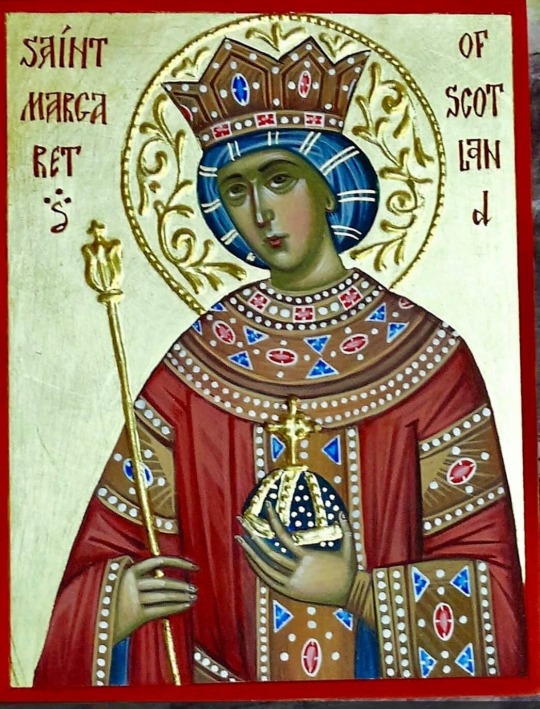
#father troy beecham#christianity#troy beecham episcopal#father troy beecham episcopal#saints#jesus#god#salvation#peace
4 notes
·
View notes